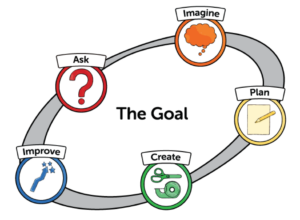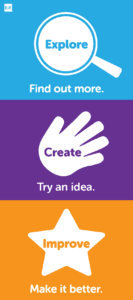In May 2022 I spent three days at the Museum of Science, Boston with a group of twenty-four enthusiastic educators. We were from different learning environments and backgrounds and had travelled from as far away as Washington state. As classroom teachers, curriculum coaches, librarians, and afterschool professionals, we sought to become confident providers of the internationally recognized EiE® curriculum and professional development. With a team of dedicated trainers, we set to work learning the foundational practices and tools that guide the pedagogy of EiE.
My attendance at this workshop served as a refresher. Since 2011, I’ve been facilitating youth and training educators in EiE units, and most recently worked to adapt the units to meet the needs of a virtual afterschool engineering and mentoring program for middle school girls and non-binary youth during the pandemic (Million Girls Moonshot and Vermont Afterschool, Inc.). As a STEM program designer, consultant, and coach, the school-age, informal learning setting was my jam, but I knew EiE had continued to evolve and grow. Since I began working with the materials, EiE has expanded their offerings to include computer science and environmental engineering (among other topics) and have made significant investments in supporting educators with extensive, point-of-use online resources. But what truly drew me to this training event was an EiE target age group that had intrigued me since I first heard about its development. EiE was now engaging preschoolers as young as 3-year-olds in hands-on, minds- on engineering, with Wee Engineer®.
The curriculum did not disappoint! During training with peer educators, we put on our “student hats” and designed rafts, noisemakers, fans, and wrecking balls while exploring the curriculum. We discussed the details and merits of each unit and considered how they might be adapted for our own learning settings. Throughout the process we all discovered the curriculum was fun, easy to implement, and that EIE had adapted its learning practices seamlessly for the new program.
What makes all EiE programs, including Wee Engineer, so bullet-proof is the accessibility of the engineering design process – the “tool” that helps students become adept at problem-solving Students of all age groups discover that engineering is not linear, but a series of iterative points that continue to cycle as they revisit an initial question: What do we need to know to solve this problem? As they progress, they will often cycle back to new “Asks” and continue to Imagine, Plan, Create and Improve their designs to reach a clearly stated goal.
With Wee Engineer this process is simplified. To be more age-appropriate, the Engineering Design Process in Wee Engineer is pared down to only three concepts – Explore, Create, and Improve. Developmentally, preschoolers respond well to music and movement to reinforce new skills. Using hand motions, singing, and puppets, EiE hits the mark in supporting early childhood educators with teaching methods that are familiar tools in their toolbox. Similarly, the materials needed for the lessons are typically already a part of a preschool classroom – blocks, craft materials, access to water, string, tape – and emphasize action-based engineering tasks. What preschooler doesn’t like to play in water or knock stuff over?

The stand-out with Wee Engineer is that there are purposeful goals beyond creating a workable design, like getting young children to express ideas, listen to peers, and be fearless in testing a design – often over and over because repetition is a hallmark of preschool learning! Wee Engineer also supports social emotional development while getting the wheels of critical thinking off to an early start.
As preschoolers catch on to what an engineer is and does, a “culture of failure” can be reinforced. Although initially this sounds counter-intuitive, failure brings knowledge of what doesn’t work toward a child’s solution to a problem and opens opportunities for new ideas! Rather than giving up and dissolving in tears, students can benefit from teachers modeling language that supports a child’s ability to persist… “Hmm, Alison, what part of your raft was sinking? What might you need to do to get the ball to hit the middle block?” These examples of purposeful questions encourage youth to observe closely and consider how the properties of other materials might do the job better.
One of my favorite parts of all EiE programs is testing materials before the design thinking gets underway. When students can see what a material can do, it gives them a leg up on their first creative attempts, creating an environment of scientific testing and discovery. It is important to scaffold science concepts whenever possible so that things like the properties of matter – what is heavy? What is stretchy? How sticky is that tape? – can be explored first before working those materials into a design plan. It is important to have choices for materials, but educators might also consider the “less is more” strategy when it comes to engineering – especially with preschoolers. Consider asking: What can I do to this material (crumple, cut, fold, tape, glue…etc.) to make it work? as an alternative to having a great many material options.
Practicing fine motor and language skills while interacting in positive ways with peers happens organically when preschoolers are engineering. They get excited! They want to share! As quoted from www.eie.org, this curriculum is about “sparking a love for STEM… creating an environment where all students can discover their inner engineer… and for educators… get hands-on [learning] to lead fun, engaging, project-based STEM experiences”. For me, I’m excited to try these units with preschoolers or with an early childhood educator as a partner, who I know will quickly latch on to the amazing impact of Wee Engineer.
I encourage educators to choose a unit, plan their strategy, team up, and try it out while making a video of themselves giving it their best shot. Or maybe secure an observer for feedback! Do what you can to improve your practice and see how engineering with preschoolers can build on their natural curiosity and a lasting love of learning about how the world works.
